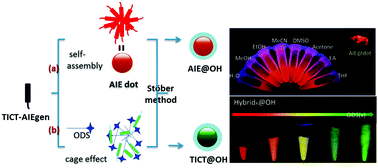Construction of emission-tunable nanoparticles based on a TICT-AIEgen: impact of aggregation-induced emission versus twisted intramolecular charge transfer†
Abstract
Traditional fluorogens with aggregation-induced emission (AIEgens) generally exhibit strong luminescence with monotonous wavelengths in the aggregated state, whereas apparent solvatochromic emission intensities and wavelengths (shift) are observed in molecules with twisted intramolecular charge transfer (TICT) characteristic molecules. Herein, we develop a platform to construct strong luminescent nanoparticles with tunable emission colors based on a TICT-AIEgen, 3,6-divinylaryl-substituted carbazole (C12P). Also based on the same molecule, through different nanoparticle fabrication approaches, fluorescent nanoparticles with different emission colors were obtained. A detailed analysis reveals that AIE and TICT characteristics play different roles in nanoparticle emission, with AIE primarily controlling the emission intensity while TICT is more involved in manipulating the emission wavelengths. Applications of the as-prepared nanoparticles in cell imaging were preliminarily demonstrated.



 Please wait while we load your content...
Please wait while we load your content...